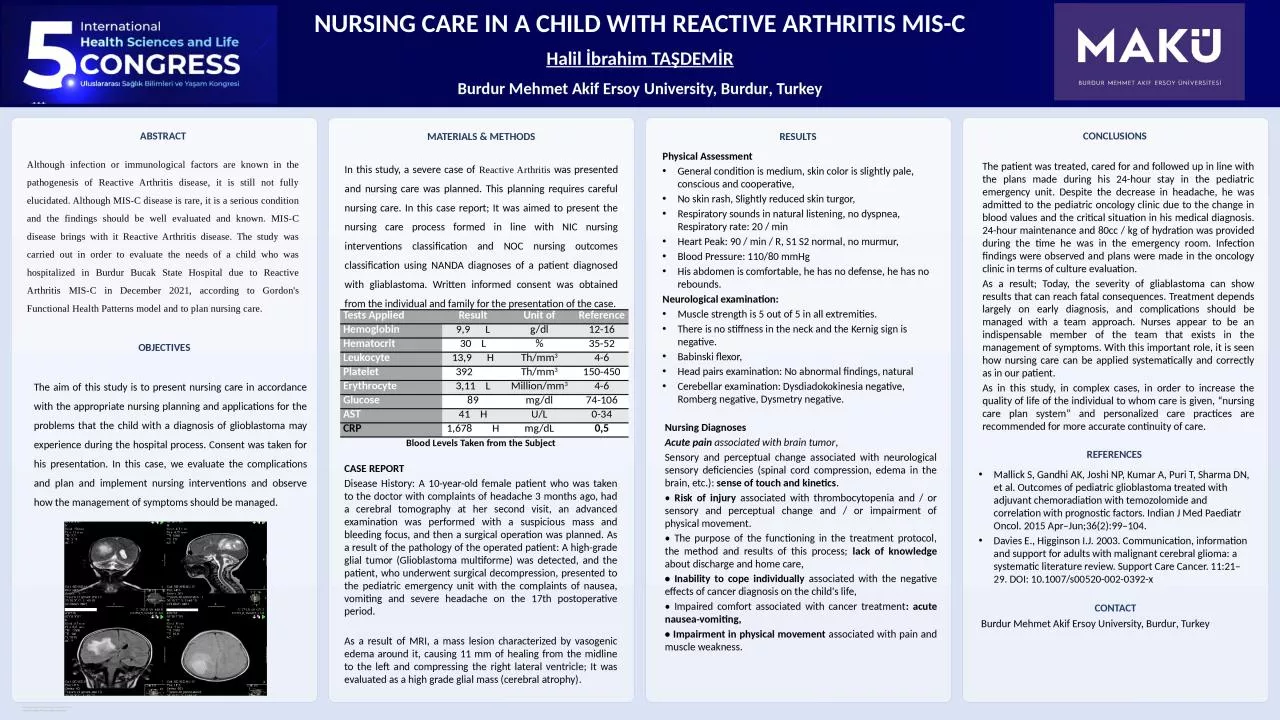

Halil İbrahim TAŞDEMİR Burdur Mehmet Akif Ersoy University Burdur Turkey ABSTRACT Although infection or immunological factors are known in the pathogenesis ID: 934979
Download Presentation The PPT/PDF document "NURSING CARE IN A CHILD WITH REACTIVE AR..." is the property of its rightful owner. Permission is granted to download and print the materials on this web site for personal, non-commercial use only, and to display it on your personal computer provided you do not modify the materials and that you retain all copyright notices contained in the materials. By downloading content from our website, you accept the terms of this agreement.
Slide1
NURSING CARE IN A CHILD WITH REACTIVE ARTHRITIS MIS-C
Halil İbrahim TAŞDEMİR
Burdur Mehmet Akif Ersoy University, Burdur, Turkey
ABSTRACT
Although infection or immunological factors are known in the pathogenesis of Reactive Arthritis disease, it is still not fully elucidated. Although MIS-C disease is rare, it is a serious condition and the findings should be well evaluated and known. MIS-C disease brings with it Reactive Arthritis disease. The study was carried out in order to evaluate the needs of a child who was hospitalized in Burdur Bucak State Hospital due to Reactive Arthritis MIS-C in December 2021, according to Gordon's Functional Health Patterns model and to plan nursing care.
OBJECTIVES
The aim of this study is to present nursing care in accordance with the appropriate nursing planning and applications for the problems that the child with a diagnosis of glioblastoma may experience during the hospital process. Consent was taken for his presentation. In this case, we evaluate the complications and plan and implement nursing interventions and observe how the management of symptoms should be managed.
MATERIALS & METHODS
In this study, a severe case of Reactive Arthritis was presented and nursing care was planned. This planning requires careful nursing care. In this case report; It was aimed to present the nursing care process formed in line with NIC nursing interventions classification and NOC nursing outcomes classification using NANDA diagnoses of a patient diagnosed with gliablastoma. Written informed consent was obtained from the individual and family for the presentation of the case.
RESULTS
Physical AssessmentGeneral condition is medium, skin color is slightly pale, conscious and cooperative,No skin rash, Slightly reduced skin turgor,Respiratory sounds in natural listening, no dyspnea, Respiratory rate: 20 / minHeart Peak: 90 / min / R, S1 S2 normal, no murmur,Blood Pressure: 110/80 mmHgHis abdomen is comfortable, he has no defense, he has no rebounds.Neurological examination:Muscle strength is 5 out of 5 in all extremities.There is no stiffness in the neck and the Kernig sign is negative.Babinski flexor,Head pairs examination: No abnormal findings, naturalCerebellar examination: Dysdiadokokinesia negative, Romberg negative, Dysmetry negative.
CONCLUSIONS
Nursing DiagnosesAcute pain associated with brain tumor,Sensory and perceptual change associated with neurological sensory deficiencies (spinal cord compression, edema in the brain, etc.): sense of touch and kinetics.• Risk of injury associated with thrombocytopenia and / or sensory and perceptual change and / or impairment of physical movement.• The purpose of the functioning in the treatment protocol, the method and results of this process; lack of knowledge about discharge and home care,• Inability to cope individually associated with the negative effects of cancer diagnosis on the child's life,• Impaired comfort associated with cancer treatment: acute nausea-vomiting,• Impairment in physical movement associated with pain and muscle weakness.
REFERENCES
Mallick S, Gandhi AK, Joshi NP, Kumar A, Puri T, Sharma DN, et al. Outcomes of pediatric glioblastoma treated with adjuvant chemoradiation with temozolomide and correlation with prognostic factors. Indian J Med Paediatr Oncol. 2015 Apr–Jun;36(2):99–104. Davies E., Higginson I.J. 2003. Communication, information and support for adults with malignant cerebral glioma: a systematic literature review. Support Care Cancer. 11:21–29. DOI: 10.1007/s00520-002-0392-x
CONTACT
Burdur Mehmet Akif Ersoy University, Burdur, Turkey
CASE REPORTDisease History: A 10-year-old female patient who was taken to the doctor with complaints of headache 3 months ago, had a cerebral tomography at her second visit, an advanced examination was performed with a suspicious mass and bleeding focus, and then a surgical operation was planned. As a result of the pathology of the operated patient: A high-grade glial tumor (Glioblastoma multiforme) was detected, and the patient, who underwent surgical decompression, presented to the pediatric emergency unit with the complaints of nausea, vomiting and severe headache on the 17th postoperative period.As a result of MRI, a mass lesion characterized by vasogenic edema around it, causing 11 mm of healing from the midline to the left and compressing the right lateral ventricle; It was evaluated as a high grade glial mass (cerebral atrophy).
Tests
AppliedResultUnit ofReferenceHemoglobin9,9 Lg/dl12-16Hematocrit30 L%35-52Leukocyte13,9 HTh/mm34-6Platelet392 Th/mm3150-450Erythrocyte3,11 LMillion/mm34-6Glucose89mg/dl74-106AST41 HU/L0-34CRP1,678 Hmg/dL0,5
The patient was treated, cared for and followed up in line with the plans made during his 24-hour stay in the pediatric emergency unit. Despite the decrease in headache, he was admitted to the pediatric oncology clinic due to the change in blood values and the critical situation in his medical diagnosis. 24-hour maintenance and 80cc / kg of hydration was provided during the time he was in the emergency room. Infection findings were observed and plans were made in the oncology clinic in terms of culture evaluation.As a result; Today, the severity of gliablastoma can show results that can reach fatal consequences. Treatment depends largely on early diagnosis, and complications should be managed with a team approach. Nurses appear to be an indispensable member of the team that exists in the management of symptoms. With this important role, it is seen how nursing care can be applied systematically and correctly as in our patient.As in this study, in complex cases, in order to increase the quality of life of the individual to whom care is given, “nursing care plan system” and personalized care practices are recommended for more accurate continuity of care.
Blood Levels Taken from the Subject